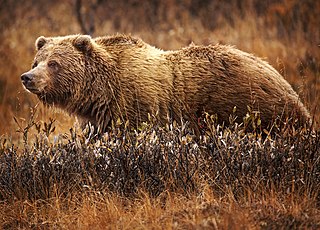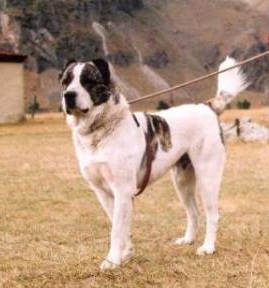
The Cornish Rex is a breed of domestic cat. The Cornish Rex has no hair except for down. Most breeds of cat have three different types of hair in their coats: the outer fur or "guard hairs", a middle layer called the "awn hair"; and the down hair or undercoat, which is very fine and about 1cm long. Cornish Rexes only have the undercoat. They are prone to hair loss and many will develop a very thin coat or even go bald over large parts of their body. The curl in their fur is caused by a different mutation and gene than that of the Devon Rex. The breed originated in Cornwall, Great Britain.

The Turkish Van is a semi-long-haired, standardised breed of domestic cat, which was developed in the United Kingdom from a selection of cats obtained from various cities of modern Turkey, especially southeast Turkey. The breed is rare, is one of the larger breeds, and is distinguished by the Van pattern, where the colour is restricted to the head and the tail, and the rest of the cat is white; this is due to the expression of the piebald white spotting gene, a type of partial leucism. A Turkish Van may have blue or amber eyes, or be odd-eyed.

The Devon Rex is a tall-eared, short-haired breed of cat that emerged in England during the late 1950s. They are known for their slender bodies, wavy coat, and large ears. This breed of cat is capable of learning difficult tricks but can be hard to motivate.

The Angora rabbit, which is one of the oldest types of domestic rabbit, is bred for the long fibers of its coat, known as Angora wool, which are gathered by shearing, combing or plucking. Because rabbits do not possess the same allergy-causing qualities as many other animals, their wool is an important alternative. There are at least 11 distinct breeds of Angora rabbit, four of which are currently recognized by the American Rabbit Breeders Association (ARBA): English Angora, French Angora, Giant Angora and Satin Angora. Others include German Angora, Chinese Angora, Finnish Angora, Japanese Angora, Korean Angora, Russian Angora, St Lucian Angora and Swiss Angora.

Cat coat genetics determine the coloration, pattern, length, and texture of feline fur. The variations among cat coats are physical properties and should not be confused with cat breeds. A cat may display the coat of a certain breed without actually being that breed. For example, a Neva Masquerade could wear point coloration, the stereotypical coat of a Siamese.

The Belgian Shepherd is a breed of medium-sized herding dog from Belgium. While predominantly considered a single breed, it is bred in four distinct varieties based on coat type and colour; the long-haired black Groenendael, the rough-haired fawn Laekenois, the short-haired fawn Malinois, and the long-haired fawn Tervuren. In the United States, the American Kennel Club considers the four varieties to be separate breeds.

Guard hair or overhair is the outer layer of hair of most mammals, which overlay the fur. Guard hairs are long and coarse and protect the rest of the pelage (fur) from abrasion and frequently from moisture. They are visible on the surface of the fur and usually lend a characteristic contour and colour pattern. Underneath the contour hair is the short, dense, fine down. There are three types of guard hair: awns, bristles, and spines.
Canine terminology in this article refers only to dog terminology, specialized terms describing the characteristics of various external parts of the domestic dog, as well as terms for structure, movement, and temperament. This terminology is not typically used for any of the wild species or subspecies of wild wolves, foxes, coyotes, dholes, jackals or the basal caninae. Dog terminology is often specific to each breed or type of dog. Breed standards use this terminology in the description of the ideal external appearance of each breed, although similar characteristics may be described with different terms in different breeds.

Coat is the nature and quality of a mammal's fur. In the animal fancy, coat is an attribute that reflects the quality of a specimen's breeding as well as the level of the animal's care, conditioning, and management. Coat is an integral aspect of the judging at competitions such as a conformation dog show, a cat show, a horse show, or a rabbit show.

The rex mutation is a genetic variation in mammals that results in soft curly fur. These effects are due to changes in the structure of groups of hairs and cross-section of individual hairs. The Rexed coats are unusual but occur in cats, rats, rabbits, horses, and dogs. The mutations, infrequent and spontaneous, occur in a variety of genes and genetic regulatory structures. The diversity of genetic factors results in variable coat thickness/density and fur length.

Rabbit hair is the fur of the common rabbit. It is most commonly used in the making of fur hats and coats, and is considered quite valuable today, although it was once a lower-priced commodity in the fur trade.

The Slovak Cuvac is a Slovak breed of dog, bred for use as a livestock guard dog. This breed—also known as Slovensky Cuvac, Slovak Chuvach, Tatransky Cuvac and Slovensky Kuvac—is closely related to the Hungarian Kuvasz. The alternate German and English spelling Tchouvatch reflects the pronunciation: chew-votch( čuvati - in serbocroatian language - guarding). The breed is recognised under sponsorship from Slovakia by the Fédération Cynologique Internationale with the name Slovenský čuvač. Despite the multiple renderings in English, these refer to only one breed. The United Kennel Club in the US uses the English version of the name Slovak Cuvac.

The term rex rabbit refers informally to one of at least nine breeds of domestic rabbit. One such breed is the Rex, which is recognized by the American Rabbit Breeders Association (ARBA) and by the British Rabbit Council (BRC). Other modern-day rex rabbit breeds are listed below. Care must be taken to distinguish the rex rabbit breeds from the three types of rex rabbit fur for which they are known.

Fur is a thick growth of hair that covers the skin of almost all mammals. It consists of a combination of oily guard hair on top and thick underfur beneath. The guard hair keeps moisture from reaching the skin; the underfur acts as an insulating blanket that keeps the animal warm.
Plush Lop is a breed of domestic rabbit with two varieties: Miniature and Standard. There is also a Canadian Plush Lop breed in development. Similar in appearance, the Velveteen Lop breed is also in development. Miniature Plush Lops were the first to be developed. Devie D'anniballe began creating this breed in 1995 in the United States. She succeeded in developing them by combining the previously existing breeds of Holland Lop, Mini Rex, and Mini Lop. Her aim was to create the perfect pet by retaining the good qualities of these breeds, while "breeding out" all the problems existing in these breeds.

The Georgian Shepherd, also known as Georgian Mountain Dog, is a breed of guard dog and livestock guardian dog from the Georgian Caucasus.

The Podenco Valenciano or Xarnego Valenciano is a hound breed of dog originating in Valencian Community, Spain. This breed is known by several names, according to the different areas of the Valencian geography: Xarnego, Xarnego Valenciano, Gos coniller, Podenco Valencíano. It was officially recognized by the Real Sociedad Canina de España in 2017.















